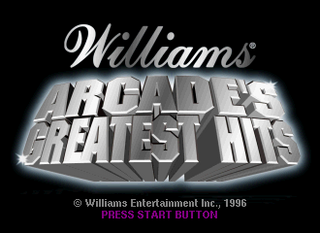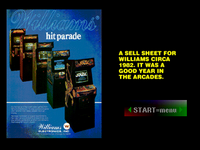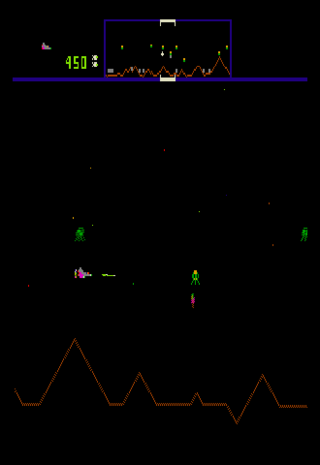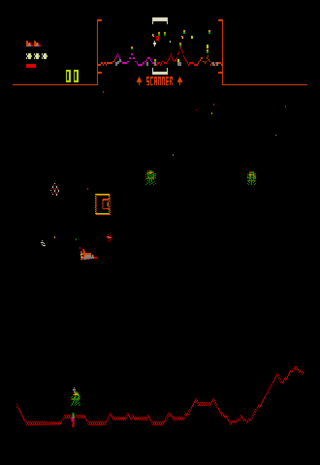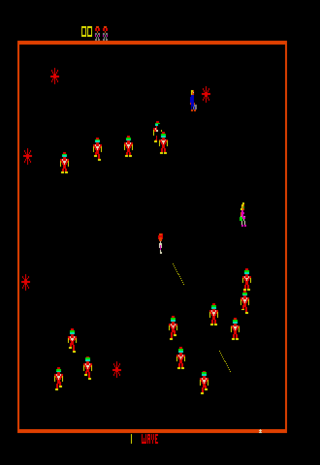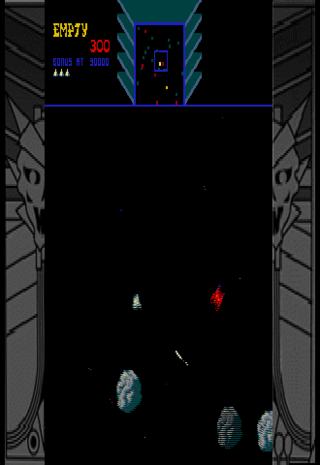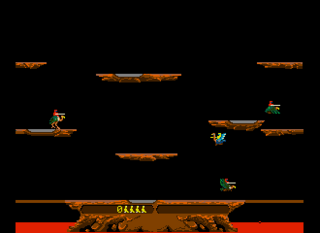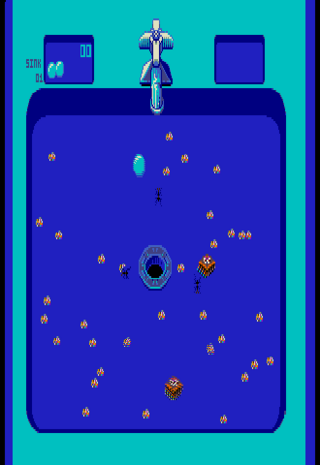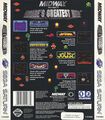Midway Presents Arcade's Greatest Hits (Saturn)
From Sega Retro
- For the Sega Mega Drive game, see Williams Arcade's Greatest Hits (Mega Drive).
| Midway Presents Arcade's Greatest Hits | ||||||||||
|---|---|---|---|---|---|---|---|---|---|---|
| System(s): Sega Saturn | ||||||||||
| Publisher: Midway Home Entertainment | ||||||||||
| Developer: Digital Eclipse | ||||||||||
| Licensor: Williams Electronics Games | ||||||||||
| Original system(s): Arcade boards | ||||||||||
| Developer(s) of original games: Williams Electronics | ||||||||||
| Game total: 6 | ||||||||||
| Peripherals supported: Saturn Floppy Drive | ||||||||||
| Genre: Compilation | ||||||||||
| Number of players: 1-2 | ||||||||||
| ||||||||||
|
Midway Presents Arcade's Greatest Hits for the Sega Saturn is a compilation of arcade games released in 1996. It contains a selection of arcade games originally released by Williams Electronics in the early 1980s. The ports were handled by Digital Eclipse, who would go on to produce numerous re-releases of this nature (including Midway Presents Arcade's Greatest Hits: The Atari Collection 1).
It is similar to the Sega Mega Drive release Williams Arcade's Greatest Hits, but it has one additional game (Bubbles), it has extras such as videos and artwork, and the games are the original arcade ROMs running in emulation rather than native reproductions. The Sega Dreamcast release Midway's Greatest Arcade Hits Volume 1 is also similar and contains the same games, although it features higher quality emulation.
Contents
Gameplay
From the game select menu, pressing ![]() loads the selected game and pressing
loads the selected game and pressing ![]() opens its extras. Every game has an article about its history that can be viewed and video clips of the developers talking about the game. There is also a gallery of images including posters and pictures of the arcade machines and developers.
opens its extras. Every game has an article about its history that can be viewed and video clips of the developers talking about the game. There is also a gallery of images including posters and pictures of the arcade machines and developers.
After loading a game, pressing ![]() starts a one-player game and pressing
starts a one-player game and pressing ![]() starts a two-player game. Pressing START at any point raises a menu allowing the players to exit back to the main menu, switch to another game without returning to the menu, or save the high scores to the Saturn's internal memory. Pressing
starts a two-player game. Pressing START at any point raises a menu allowing the players to exit back to the main menu, switch to another game without returning to the menu, or save the high scores to the Saturn's internal memory. Pressing ![]() +
+![]() + START at any point opens the arcade operator test mode.
+ START at any point opens the arcade operator test mode.
| Defender (1980) | |
|---|---|
| Defender is a 2D side-scrolling shoot-'em-up. The player controls a starship flying above the surface of a planet and must shoot alien invaders, avoid projectiles and obstacles, and protect humans on the ground from being captured. It is the primary influence for the Sega classic, Fantasy Zone. Attack waves of alien invaders warp in at the beginning of each level, and the level is completed after every alien has been destroyed.
The ship moves in any direction using the D-Pad. The ship can fly in either direction, left or right, with the environment "looping" to create a "circular" playfield. A miniature view of the entire playfield is shown in the top of the screen, which includes the positions of enemies and humans. The ship fires its main weapon, a long laser beam, with Some alien spacecraft attempt to abduct humans by picking them up from the ground and carrying them to the top of the screen, turning them into fast-moving mutant enemies. The player can free the human by shooting the alien, then catching the human before they fall to their death, and dropping them off on the ground. The ship is destroyed if it is hit by an enemy, but it respawns if the player has an extra ship remaining. It is not harmed by flying into the terrain. Each player starts the game with three ships and earns another ship and another smart bomb for every 10,000 points earned. The game continues indefinitely or until the player runs out of ships. There is a two-player alternating mode where players take turns sharing the same control pad. | |
| Defender II (Stargate) (1981) | |
| Defender II is the sequel to Defender (though, for legal reasons, it only ever known as Stargate in arcades, with the Defender II name used for some of the home releases). As before, it is a 2D side-scrolling shoot-'em-up where the player pilots a starship above a mountainous landscape, destroying all of the alien invaders in a level in order to progress to the next. The game introduces new enemies, a cloaking device, and "Stargates" that the ship can fly through to warp across the playfield.
The ship moves in any direction using the D-Pad. The landscape loops around in both directions. A "scanner" appears in the top of the screen that shows a miniature view of the entire playfield, which displays the positions of all aliens and humans. The ship fires its main weapon, a long laser beam, with Some alien spacecraft attempt to abduct humans by picking them up from the ground and carrying them to the top of the screen, turning them into fast-moving mutant enemies. The player can free the human by shooting the alien, then catching the human before they fall to their death, and dropping them off on the ground. If an alien is capturing a human, entering a Stargate warps the player's ship to the human in distress; otherwise, the Stargate warps the ship to the other side of the playfield. If the player has rescued at least four humans, entering a Stargate in one of the first ten levels warps the player ahead by three levels. The ship is destroyed if it is hit by an enemy, but it respawns if the player has an extra ship remaining. It is not harmed by flying into the terrain. Each player starts the game with three ships, and the player is given another ship, another smart bomb, and full Inviso cloaking energy for every 10,000 points earned. The game continues indefinitely or until the player runs out of ships. There is a two-player alternating mode where players take turns sharing the same control pad. | |
| Robotron 2084 (1982) | |
| Robotron 2084 is a dual-joystick top-down shoot-'em-up. In the year 2084, robots have started a war against humans, and the player must attempt to save the last surviving human family from them. It is considered a predecessor to Smash TV, as it was created by the same developer and uses a similar control scheme. This game traditionally causes problems on systems with less than four face buttons (such as the Mega Drive), as eight-directional firing is hindered without a means to emulate the dual joysticks, making the game significantly harder. The game presents the playfield from an overhead perspective, and the player must eliminate all of the enemy robots in a level to progress to the next one. Touching a human rescues the family member for bonus points.
The Robotron hero moves in any direction using the D-Pad on the first control pad. The player can use the D-Pad on the second control pad to fire in any of the eight directions. Alternatively, the player can use The player loses a life if the Robotron hero is killed by an enemy. Each player starts the game with three lives and earns another for every 25,000 points earned. The game continues until the player runs out of lives or decides to stop playing. There is a two-player alternating mode where players take turns sharing the same control pads. | |
| Sinistar (1982) | |
| Sinistar is a top-down shooter similar to Atari's Asteroids. The player controls a spaceship that is flying in a region of space. Destroying planetoids releases small white crystals that can be collected to make a "Sinibomb," which is the weapon necessary for defeating the "Sinistar" at the end of each level. Red enemy worker ships construct the Sinistar during the level. The worker ships cannot harm the player's ship but compete with the player for mining crystals. Once the Sinistar is complete, the player must destroy it to move on to the next zone, where the process repeats.
The ship moves in any direction using the D-Pad. Moving the D-Pad not only moves the ship around in space but also rotates it, which affects its direction of fire. It shoots its gun in the direction that it is facing with The ship is destroyed if it is hit by an enemy, but it respawns if the player has an extra ship remaining. Each player starts the game with three ships, and the player is given another ship at 30,000 points (which increases by another 30,000 points after every bonus ship earned). The game continues indefinitely or until the player runs out of ships. There is a two-player alternating mode where players take turns sharing the same control pad. | |
| Joust (1982) | |
| Joust is a single-screen platform game in which players control a knight riding a large bird (an ostrich for player one and a stork for player two). The level contains several platforms and wraps around in both directions (so walking through one side of the screen moves the knight to the other side). The knights must defeat the enemy knights riding buzzards by jumping on top of them. All knights are armed with lances, as in traditional jousting, and the knight whose lance is higher wins the engagement; if the lances are at the same level, both knights are repelled away. Defeated enemies are turned into eggs, which can be collected for bonus points; if not collected in time, the eggs hatch into more difficult enemy knights. The level ends when all of the knights have been defeated and their eggs have been collected or hatched.
The knights can move with A player loses a life if the player's knight is unseated by an enemy or the other player. Each player starts the game with five lives and earns another for every 20,000 points earned. The game continues until the players run out of lives or decide to stop playing. There is a two-player cooperative mode where players play simultaneously using separate control pads. | |
| Bubbles (1982) | |
| Bubbles is an action game where players control a bubble and need to clean a sink. The bubble moves in any direction using the D-Pad. Its movement is slippery, so it continues to slide even after the player stops holding the direction. The bubble can move over ants, crumbs, and grease spots to absorb them before they slide into the drain. As the bubble absorbs things, it grows in size (eventually developing a face). The level ends if the player succeeds in cleaning everything in the sink. If the bubble has grown large enough to have a face, the player moves on to the next level; otherwise, the player loses a life and must play the same level again.
Sponges and scrub brushes also move around the sink, cleaning it in competition with the player. They can be knocked into the drain but only after the bubble has grown enough to have a face (otherwise, touching them costs the player a life). Other enemies include stationary razor blades that appear in the sink and roaches that crawl out of the drain. Touching the blade always costs a life, but the bubble can pick up a broom by running over a cleaning lady (who sometimes appears in the sink), which allows it to absorb a roach. Entering the drain while the bubble is small costs a life. Entering the drain when the bubble has a face skips to the next level. The game continues until the players run out of lives or decide to stop playing. There is a two-player alternating mode where players take turns sharing the same control pad. |
Production credits
- Developed by Digital Eclipse Software, Inc.
- Programming: Dan Filner
- Executive Producer: Andrew Ayre
- Arcade Hardware Guru: Jeff Vavasour
- Assistant Producer: John Stookey
- Animation and Artwork: Midnight Design
- History and Video Interviews: Jon Bradley Snyder, Chris Charla, Flying Rhino Productions
- Williams Entertainment Testing: Ross Deynata, Jason Shigenaka, William Sutjiadi, John Ubalde
- Special Thanks to: George and Peter Phillips, Tim "dib.c" Mensch, Weird Blinking Lights
- Program/Design: Eugene Jarvis, Sam Dicker
- Additional Programming: Larry DeMar, Paul Dussault
- Character Graphics: Eugene Jarvis, Larry DeMar
- Sounds: Sam Dicker
- Cabinet Art: Constantino Mitchell
- Game Consultant: Steve Ritchie
- Hardware: Chuck Bleich
- Concept/Design: John Newcomer
- Software: Bill Pfutzenreuter
- Artist: Jan Hendricks
- Sounds: John Kotlarik, Tim Murphy
- Support Software: Cary Kolker, Ken Lantz
- Support Art: John Newcomer, Python Anghelo
- Hardware: Greg Wepner
- Mechanical: Leo Ludzia
- Cabinet Art: Constantino Mitchell
- Program/Design: Eugene Jarvis, Larry DeMar
- Cabinet Art: Constantino Mitchell
- Character Graphics: Eugene Jarvis, John Sheldrake, Larry DeMar, Ken Roberts
- Hardware: Greg Wepner, Chuck Bleich
- Special Thanks: Mike Stroll, Nate Dardick
- Program/Design: John Kotlarik, Tim Murphy
- Art/Design: Python Anghelo
- Support Software: Dave Rzepka
- Sounds: John Kotlarik, Tim Murphy
- Hardware: Chuck Bleich, Greg Wepner
- Mechanical: Leo Ludzia, Gary Berge
- Video Manager: Ken Lantz
- Program/Design: Eugene Jarvis, Larry DeMar
- Executive Producer: Mike Stroll
- Character Graphics: Larry DeMar, Eugene Jarvis
- Sounds: Eugene Jarvis, Sam Dicker
- Cabinet Art: Constantino Mitchell
- Hardware: Chuck Bleich
- Design: Noah Falstein, Sam Dicker, Jack Haeger, R. J. Mical, Richard Witt
- Software: Noah Falstein, Sam Dicker
- Artist: Jack Haeger
- Support Software: Bob Mical, Richard Witt
- Preliminary Design: John Newcomer
- Hardware: Greg Wepner
- Mechanical: Leo Ludiza, Gary Berge
- Video Manager: Len Lantz
- Williams is a registered trademark of Williams Electronics Games, Inc.
- Arcade's Greatest Hits © 1996 Midway Home Entertainment Inc. All Rights Reserved
- Defender © 1980, 1996; Defender II © 1981, 1996; Robotron: 2084 © 1982, 1996; Joust © 1982, 1996; Sinistar © 1982, 1996; Bubbles © 1983, 1996 Williams Electronics Games, Inc. All Rights Reserved.
- Defender, Joust, Robotron: 2084, Sinistar, and Bubbles are registered trademarks of Williams Electronics Games, Inc. Midway is a registered trademark of Midway Games, Inc. Used by permission. Digital Arcade (tm) Emulation Software Copyright 1996 Digital Eclipse Software Inc.
- Digital Eclipse and the Digital Eclipse Logo are trademarks of Digital Eclipse Software, Inc.
- Developed by Digital Eclipse Software, Inc.
- Programming: Dan Filner
- Executive Producer: Andrew Ayre
- Assistant Producer & Arcade Hardware Guru: Jeff Vavasour
- Animation & Artwork: Midnight Design
- History & Video Interviews: Jon Bradley Snyder, Chris Charla, Flying Rhino Productions
- Special Thanks: George Phillips, Peter Phillips, Todd Frye and Tim Mensch
- Associate Producer: John Stookey
- 'Print Design & Production: Debbie Austin, Shawn Murphy, Dave Young, Jon Mongelluzzo, Robert Shepherd
- Williams Entertainment Testing: John Ubalde, Jason Shigenaka, William Sutjiadi, Ross Deynata
- Special Thanks: Michael Rubinelli, Jim Flaharty, Michael Gottlieb, Kathy Progar, Herb Galindo, Zaragoza
Magazine articles
Promotional material
Physical scans
| Sega Retro Average | |||||||||
|---|---|---|---|---|---|---|---|---|---|
|
| 80 | |
|---|---|
| Based on 1 review | |
Technical information
References
- ↑ http://www.sega-saturn.com/saturn/software/williams.htm (Wayback Machine: 1997-06-06 06:13)
- ↑ File:Midway Presents Arcade's Greatest Hits Saturn credits.pdf
- ↑ File:Wagh sat us manual.pdf, page 14
- ↑ GamesMaster, "June 1998" (UK; 1998-05-21), page 80
- ↑ Sega Saturn Magazine, "September 1997" (UK; 1997-08-13), page 72
| Midway Presents Arcade's Greatest Hits (Saturn) | |
|---|---|
|
Main page | Comparisons | Magazine articles | Reception | Technical information | |
| Midway, Williams and Atari compilations for Sega systems | |
|---|---|
| Arcade Smash Hits (1992) | |
| Arcade Classics (1996) | Williams Arcade's Greatest Hits (1996) | |
| Arcade Classics (1996) | |
| Midway Presents Arcade's Greatest Hits (1996) | Midway Presents Arcade's Greatest Hits: The Atari Collection 1 (1997) | |
| Midway's Greatest Arcade Hits Volume 1 (2000) | Midway's Greatest Arcade Hits Volume 2 (2000) | Atari Anniversary Edition (2001) | Midway's Greatest Arcade Hits Volume 3 (unreleased) | |
